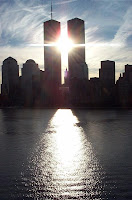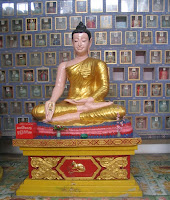Melaka – The City That Time May Forget Melaka, once known as Malacca, located on the Straits of Melaka has a romantic history, but its  modern Disney-like makeover makes it a comfortable, but possibly a forgettable tour site. There is much to see in Melaka, but if one is searching for a rustic view of Asian culture and history, another venue may be needed.
modern Disney-like makeover makes it a comfortable, but possibly a forgettable tour site. There is much to see in Melaka, but if one is searching for a rustic view of Asian culture and history, another venue may be needed.
Streets bustle with private cars and are lined with fully stocked shops, first class hotels and well groomed tourist attractions. Melaka has reinvented itself from its legendary founding by the Sumatran prince Parameswara in 1390. Legend recounts  that while taking rest beneath a tree, one of Parameswara’s hunting dogs cornered a small mouse-deer. The spindly legged mouse-deer met the challenge and attacked the dog. Admiring the courage of the small mouse-deer, Parameswara founded Melaka on that spot
that while taking rest beneath a tree, one of Parameswara’s hunting dogs cornered a small mouse-deer. The spindly legged mouse-deer met the challenge and attacked the dog. Admiring the courage of the small mouse-deer, Parameswara founded Melaka on that spot .
.
By the mid 1400’s, Melaka was a booming trading post for Javanese, Indian, Arab, Persian and Chinese merchants. Melaka’s trading success attracted the attention of the Portuguese. In 1511, they succeeded in capturing the city. They built A Famosa, or Porta De Santiago, to protect their possession. The defensive strategy worked for 130 years, until the Dutch displaced the Portuguese. Control passed back and forth between the Dutch and the British. With independence in 1957, control once again returned to local citizens.
With such a past the people of Melaka emerged with a distinctive Peranakan culture.  Peranakan in Malay means “descendants” and the Chinese descendents from original traders fashioned their own traditions, dress and foods. Male descendants are call Babas; females Nyonyas or Nonyas. We visited the privately operated Baba-Nonya Heritage Museum for a
Peranakan in Malay means “descendants” and the Chinese descendents from original traders fashioned their own traditions, dress and foods. Male descendants are call Babas; females Nyonyas or Nonyas. We visited the privately operated Baba-Nonya Heritage Museum for a delightful guided tour of a once very prosperous Baba-Nonya home. Rich Chinese embroidered artwork hung from the walls and Italian tile graced the floor. English dishware and flatware were displayed with a 100+ year unopened bottle of brandy.
delightful guided tour of a once very prosperous Baba-Nonya home. Rich Chinese embroidered artwork hung from the walls and Italian tile graced the floor. English dishware and flatware were displayed with a 100+ year unopened bottle of brandy.
 From there we walked the short distance to the river quay to tour a replica of the Portuguese merchant ship, Flora de la Mar. Freed of internal decking, we were amazed at the ship’s enormous cargo capacity. The museum-ship’s air-conditioned interior held displays in English and Malaysian on the history of the Melakan trade and the duties levied that made this river quay such a prosperous enterprise for those who possessed it.
From there we walked the short distance to the river quay to tour a replica of the Portuguese merchant ship, Flora de la Mar. Freed of internal decking, we were amazed at the ship’s enormous cargo capacity. The museum-ship’s air-conditioned interior held displays in English and Malaysian on the history of the Melakan trade and the duties levied that made this river quay such a prosperous enterprise for those who possessed it.
 We then headed inland to visit the hilltop ruins of St. Paul’s Church. Built in 1521 by the Portuguese, the Dutch reclaimed it and buried their dead beneath carved flooring slabs. The church is but a shell today. A few tombstones rest against the interior walls providing a backdrop to merchants and musicians. The location of the temporary burial site of St. Francis Xavier is not officially marked, but the metal caging over an open pit in the church appears to “protect” this sacred ground.
We then headed inland to visit the hilltop ruins of St. Paul’s Church. Built in 1521 by the Portuguese, the Dutch reclaimed it and buried their dead beneath carved flooring slabs. The church is but a shell today. A few tombstones rest against the interior walls providing a backdrop to merchants and musicians. The location of the temporary burial site of St. Francis Xavier is not officially marked, but the metal caging over an open pit in the church appears to “protect” this sacred ground.
 We visited the fragmentary remains of the Portuguese A Famosa and then idled some time in a nearby Mega Shopping Mall and the Bamboo Hut Restaurant, awaiting nightfall to watch the nearby Sound & Light Show. From the restaurant we watched the parade of highly decorated pedicabs, some with blaring sound systems, transporting tourists along the n
We visited the fragmentary remains of the Portuguese A Famosa and then idled some time in a nearby Mega Shopping Mall and the Bamboo Hut Restaurant, awaiting nightfall to watch the nearby Sound & Light Show. From the restaurant we watched the parade of highly decorated pedicabs, some with blaring sound systems, transporting tourists along the n eat brick esplanade. Alas, we discovered the Sound & Light show was cancelled for this evening. We strolled back to the Mekala Renaissance, enjoying the cool night air, then prepared for our return trip to KL the next day.
eat brick esplanade. Alas, we discovered the Sound & Light show was cancelled for this evening. We strolled back to the Mekala Renaissance, enjoying the cool night air, then prepared for our return trip to KL the next day.



 We missed the Thaipusam festival by a few weeks. During this festival, over a million devotees of Lord Murugan congregate at
We missed the Thaipusam festival by a few weeks. During this festival, over a million devotees of Lord Murugan congregate at 















































